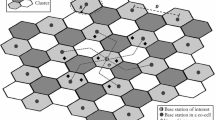Abstract
This paper investigates the application of Reed-Solomon coding on DS/CDMA systems with M-ary orthogonal signaling for the reverse link of a microcellular environment. The performance of voice and data communications are analytically evaluated for a Rician or Rayleigh faded channel with lognormal shadowing and a two-slope path loss model. The effects of sectorization and antenna diversity are also considered. Numerical results, in terms of bit error probability and throughput, show that with proper selection of the coding rate and spreading, the proposed system presents enhanced performance with moderate complexity.
Similar content being viewed by others

References
K.S. Gilhousen et al., “On the Capacity of a Cellular CDMA System”, IEEE Trans. Vehic. Technol., Vol. 40, No. 2, pp. 303-312, 1991.
M.G. Jansen and R. Prasad, “Capacity, Throughput, and Delay Analysis of a Cellular DS CDMA System With Imperfect Power Control and Imperfect Sectorization”, IEEE Trans. Vehic. Technol., Vol. 44, No. 1, pp. 67-75, 1995.
P.K. Enge and D.V. Sarwate, “Spread-Spectrum Multiple Access Performance of Orthogonal Codes: Linear Receivers”, IEEE Trans. Commun., Vol. COM-35, No. 12, pp. 1309-1319, 1987.
K. Pahlavan and M. Chase, “Spread-SpectrumMultiple Access Performance of Orthogonal Codes for Indoor Radio Communications”, IEEE Trans. Commun., Vol. 38, No. 5, pp. 574-577, 1990.
M. Chase and K. Pahlavan, “Performance of DS-CDMA Over Measured Indoor Radio Channels Using Random Orthogonal Codes”, IEEE Trans. Vehic. Technol., Vol. 42, No. 4, pp. 617-624, 1993.
A.J. Viterbi et al., “Performance of Power-Controlled Wideband Terrestrial Digital Communication”, IEEE Trans. Commun., Vol. 41, No. 4, pp. 559-569, 1993.
L.F. Chang et al. “Comparison of Two Convolutional Orthogonal Coding Techniques for CDMA Radio Communications Systems”, IEEE Trans. Commun., Vol. 43, No. 6, pp. 2028-2037, 1995.
A. Jalali and P. Mermelstein, “Effects of Diversity, Power Control, and Bandwidth on the Capacity of Microcellular CDMA Systems”, IEEE Journal on Selec. Areas in Commun., Vol. 12, No. 5, pp. 952-961, 1994.
L.M.A. Jalloul and J.M. Holtzman, “Performance Analysis of DS/CDMA with Noncoherent M-ary Orthogonal Modulation in Multipath Fading Channels”, IEEE Journal on Selec. Areas in Commun., Vol. 12, No. 5, pp. 862-870, 1994.
E.K. Hong et al., “Performance Evaluation of DS-CDMA System with M-ary Orthogonal Signaling", IEEE Trans. Vehic. Technol., Vol. 45, No. 1, pp. 57-63, 1996.
A.C. Iossifides and F-N. Pavlidou, “Performance Evaluation of DS/CDMASystems Using M-ary Orthogonal Coding Over Indoor Fading Channels”, in Proc. PIMRC'97, Helsinki, Finland, pp. 693-697, 1997.
M-H. Fong et al., “Concatenated Orthogonal/PN Spreading Sequences and Their Application to Cellular DS-CDMA Systems with Integrated Traffic”, IEEE Journal on Selec. Areas in Commun., Vol. 14, No. 3, pp. 547-558, 1996.
R. Prasad, CDMA for Wireless Personal Communications, Artech House, Inc., 1996.
B.D. Woerner and W.E. Stark, “Trellis-Coded Direct Sequence Spread-Spectrum Communications”, IEEE Trans. Commun., Vol. 42, No. 12, pp. 3161-3170, 1994.
J.G. Proakis, Digital Communications, 2nd edn., McGraw-Hill, 1989.
A.M. Michelson and A.H. Levesque, Error-Control Techniques for Digital Communication, John Wiley & Sons, 1985.
E. Geraniotis and J.W. Gluck, “Coded FH/SS Communications in the Presence of Combined Partial-Band Interference, Noise Jamming, Rician Nonselective Fading, and Multiuser Interference”, IEEE Journal on Selec. Areas in Commun., Vol. SAC-5, pp. 194-214, 1987.
A.M.Y. Bigloo et al., “A Robust Rate-Adartive Hybrid ARQ Scheme for Frequency-Hopped Spread-Spectrum Multiple-Access Communication Systems”, IEEE Journal on Selec. Areas in Commun., Vol. 12, No. 5, pp. 917-924, 1994.
R.J.C. Bultitude and G.K. Bedal, “Propagation Characteristics on Microcellular Urban Mobile Radio Channels at 910 MHz”, IEEE Journal on Selec. Areas in Commun., Vol. 7, No. 1, pp. 31-39, 1989.
D.L. Noneaker and M.B. Pursley, “On the Chip Rate of CDMA Systems with Doubly Selective Fading and Rake Reception”, IEEE Journal on Selec. Areas in Commun., Vol. 12, No. 5, pp. 853-861, 1994.
G-T. Chyi et al., “On the Symbol Error Probability of Maximum-Selection Diversity Reception Schemes Over a Rayleigh Fading Channel”, IEEE Trans. Commun., Vol. 37, No. 1, pp. 79-83, 1989. 52 A.C. Iossifides and F-N. Pavlidou
Author information
Authors and Affiliations
Rights and permissions
About this article
Cite this article
Iossifides, A., Pavlidou, FN. Performance of RS-Coded DS/CDMA Microcellular Systems with M-ary Orthogonal Signaling. Wireless Personal Communications 10, 33–52 (1999). https://doi.org/10.1023/A:1018368706447
Issue Date:
DOI: https://doi.org/10.1023/A:1018368706447



